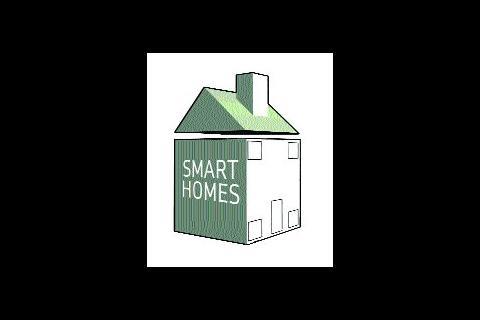There’s so much more to the smart home than movies on demand. IP communication systems could deliver health services, education, security and energy monitoring. Mike Perry explains
In December last year a turning point was reached. For the first time in the UK, transactions for Christmas trading over the internet exceeded those on the high street.
It was the introduction in the late 1990s of internet protocol (IP) technologies that sparked the revolution in the way we communicate and carry out our day-to-day business. In the office it drove the uptake of services such as video conferencing while on the domestic front its potential for purchasing goods, online banking and video on demand services was quickly realised.
However, there is huge potential for IP communications systems to bring about an equally radical revolution in the way we monitor and manage our homes and deliver community services such as healthcare.
A smart home can largely be defined as a one that has an internal communications network with access to external broadband connectivity. About 90% of UK housing has access to broadband services but only a small proportion has an internal network for distributing voice, data and video signals throughout the house.
Ideally, to take full advantage of the connected society all houses would be internally “wired” with a distributed communications network. Currently only about 1000-2000 new homes a year would rank as smart homes, mostly driven by lifestyle and entertainment choices. This accounts for just 1% of new housing stock and is a substantial missed UK housing.
Huge potential benefits
But if the opportunity could be realised there are huge benefits. Domestic dwellings account for over a quarter of all primary energy use in the UK. Smart home systems provide the potential for interactive monitoring and management of both energy and water use in the home, supplying the means for end users to significantly reduce consumption and avoid waste.
The same systems can also be used for remote monitoring and management. This could, for example, facilitate developments in the delivery of telecare and to monitor homes susceptible to fuel poverty over winter. Home environmental monitoring and management systems can also be used.
The widespread availability of communications systems also provides a means for radically changing the way healthcare is delivered.
A major policy shift is taking place whereby an increasing proportion of services will take place in the community rather than through acute hospitals. Several imperatives are driving this policy shift, including the increasing number of people aged 60 or over, a figure which is set to rise to almost 20 million between 2020 and 2030.
Secure, reliable broadband connectivity and internal communications networks supporting the remote delivery of health and social services in the community will help offset the rising costs of providing these services. The same communications infrastructure can also be used for education in the community.
Wired-up communities
Linking the internal communications systems of a house with the external internet in a local area creates the opportunity for a wired-up community, providing a method for broadcasting important local information.
These services could be delivered through a set-top box – avoiding the need for a computer and could include free-to-air TV, video-on-demand, CCTV and shopping services. There could also be news services, jobs advertising and information on local events.
This is all well and good, but setting up and operating a wired community takes financing. One solution is to establish a local investment company. These are a mixture of local public service organisations and private companies with an interest in the commercial supply of the community services. The latter have been one of the primary drivers for installation of the broadband infrastructure.
Despite all the benefits, there are of course barriers to the uptake of smart home technologies. IP technologies are a recent phenomenon less than 10 years old and are regarded by house developers and builders as being innovative and therefore inherently risky. The risks include uncertainty about the technology involved, its cost, installation, commissioning requirements and ongoing liabilities.
The capital and installation costs of a basic communications infrastructure with one master point and six additional connection points (one computer; two phone; two satellite TV; one terrestial TV; one radio) in a typical three-to-four bedroom property was of the order £800 in 2006, with costs falling as demand volumes increase.
Another barrier at the present time is the absence of regulatory requirements or guidance documents for the installation of connectivity technology in the home. An earlier consultation draft of the proposed Building Regulations Part Q was predicated on the installation requirements for ducting to carry the cable infrastructure for the internal transmission of data in the home setting. But ratification of Part Q proved difficult, not least because IP technologies develop at a timescale many times faster than the timescale regulatory processes operate to. The government has responded by producing a draft guidance document, Data Services – Connecting to Homes, which will be better able to keep pace with technological developments than a regulatory document that needs to be ratified.
In terms of the physical installation in the home, it uses a familiar medium – cable. Typically the communications cable used is Cat5e (with an analogue bandwidth of 100 MHz, supporting data transfer at up to 1000 Mbits/s). The more expensive and more capable Cat6 cable is also used (analogue bandwidth of 250MHz, and expected to be adequate for 10,000 baseT (10 Gbits/s) ethernet) both twisted pair cable types.
Those advocating the use of Cat 6 or better often do so because of its superior ability to carry analogue video. In an increasingly IP-based world, this will become less important.
Bandwidth is an estimate of the information carrying capacity of a medium, cable in this case. The greater the bandwidth, the greater the information capacity. For example, the typical bandwidth requirements for digital transmission of encoded high quality, high-definition video transmission can reach 40 Mbits/s. For comparison, DVD format can be up to 9.8 Mbits/s for video plus audio, though lower rates are common. While the cable medium is familiar, these communications cables require careful handling, and have more precise termination requirements than electrical light and power cables.
Installation quality is critical
The success of smart home communications relies on the quality of the installation. Poor workmanship will reduce bandwidth and quality of service. Termination of the external cable or fibre optic is another critical requirement. Basic training in cable handling and termination is not overly complex, but essential if the communications installation is to operate to its maximum capacity and deliver a high quality of service. A key consideration in the appointment of contractors is identifying their technical accreditations for installation of communications infrastructure in the domestic setting.
Financing models are the other fundamental in the development and implementation of wired-up communities, and similar projects. Consumer packages offered by companies such as Sky and Virgin are based on well-developed cost models, with clear identification of profits. Individual consumers are incentivised to pay their subscriptions to these types of service because of their perceived entertainment and amenity value. The perceived value of public services is much lower. Complicating the issue of financing local community services through the internet may be an expectation of free delivery of service.
Local investment companies
Identifying financial models to support delivery of local community services is therefore a significant challenge, and may rely on the setting up of local investment companies - bringing together local public service organisations, eg local authorities, with companies with an interest in the commercial delivery of public services. The prospective environmental, social and economic benefits of providing connectivity in the home setting are substantial in some contexts they may be irrefutable, eg supporting the remote delivery of healthcare services in the home.
There are a number of significant barriers to be addressed in establishing wide spread uptake of the integrated, connected home. Possibly the most significant of these issues to be addressed in the future is in the development of integrated connectivity for existing housing stock.
A demonstration project by BRE and its partner OpenHub will showcase the technologies in an innovative new-build house by construction products provider Hanson. The house and its smart integrated communications network will demonstrate the benefits for the home owner and for society in general and will hopefully be a catalyst for a change in attitudes towards integrated smart technology in the home.
Mike Perry is associate director of BRE Enterprise and Innovation The smart homes demonstration project will be launched at the Offsite2007 event, which takes place at the BRE on 11-14 June.
Cable vs wireless
Retrofitting cable in homes is expensive, messy and disruptive, and likely to result in a communications installation of significantly lower quality than in a new build or major refurbishment.
This is a major challenge to the roll-out of the connected home more than 95% of housing is existing stock. How can this be cost-effectively installed with integrated communications? While the use of wireless technologies is attractive, there are a number of issues:
Source
Building Sustainable Design
























No comments yet